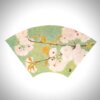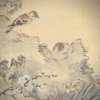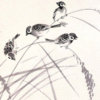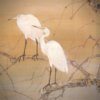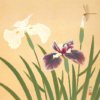Ōhashi Suiseki’s Summary | The Best of Tiger Painters (1/3)

Contents
The State of Japanese Art in Ōhashi Suiseki’s Early Years
Early Meiji Period: the Great Devastation of Japanese Art
Ōhashi Suiseki was born in Gifu prefecture in 1865, at the very end of the Edo period (1603-1868), when the Japanese art world was in the midst of a period of great change, as the long-lasting Edo period came to an end and the new Meiji period began. In 1868, the Meiji government issued a decree separating Buddhism from Shintoism, and the movement to abolish Buddhism spread throughout Japan, devastating Japanese Buddhist art. In addition to this, the end of the shogunate system in the Edo period brought an end to the master-painter relationship, and the loss of patrons led to a large number of painters being forced into poverty. The Kano school of painters, which flourished in the Edo period, was no exception, and even Kano Hōgai, whose “Kannon (Goddess of Mercy)” is one of the absolute masterpieces in the history of Japanese painting, and Hashimoto Gahō, one of the leading figures in Japanese painting in the Meiji period, had to live in poverty at times. The influx of Western paintings further diminished the value of Japanese art, and Japanese art was greatly devastated in the early Meiji period.
Birth of the Concept of Japanese-style Paintings
The Ryūchi-kai (later the Nihon Bijutsu Kyōkai) was founded in 1878 by a group of government officials with the aim of protecting Japanese art. The protection of Japanese art begins with this association. Ernest Fenollosa, who had come to Japan to teach Western philosophy to the Japanese, was one of the brains of the group. (Fenollosa had always had a keen interest in art, having studied oil painting and drawing in his own country, and after coming to Japan he became increasingly interested in Japanese art.) In 1882, Fenollosa gave a lecture entitled “Bijutsu Shinsetsu” at a conference organised by the Ryūchi-kai, in which he compared the characteristics of Japanese and Western paintings and argued for the superiority of Japanese paintings. It was during this lecture that the term “Japanese-style painting” was used for the first time and the concept of “Japanese-style painting” was born.
After this, Fenollosa distanced himself from the traditional idea of the Ryūchi-kai, which aimed at the pure preservation of Japanese art, and launched the Kanga-kai, which aimed at innovating Japanese painting into a world-class style by adding the essence of Western painting to the traditional Japanese painting. Together with Okakura Tenshin, Kanō Hōgai, Hashimoto Gahō, and others, Fenollosa began his search for a new style of Japanese painting.
In 1887, the Tokyo School of Fine Arts, a government-run art school, was established, and under the leadership of Okakura Tenshin, the school’s first president, artists such as Yokoyama Taikan, Hishida Shunsō, and Shimomura Kanzan began to emerge.
Ōhashi Suiseki’s Childhood – Training Period
Ōhashi Suiseki, who had studied painting with his father, loved to draw pictures from his childhood. 1880 (Meiji 13, at the age of 15), he studied painting with a local painter Toda Hodō, and then with Hodō’s master Amano Hōko in Kyoto. In 1886 (Meiji 18, at the age of 21), he apprenticed himself to Watanabe Shōka in Tokyo.
Period of Hardship – Encounter with a Tiger
Sudden Death of His Mother and Master
In 1887, the year after Ōhashi Suiseki moved to Tokyo to study under Watanabe Shōka, his mother and Watanabe Shōka died suddenly, and deep grief overcame Ōhashi Suiseki. Suiseki returned to his hometown and began to study painting on his own.
Nōbi Earthquake and Death of His Father
Life back home was short-lived when, in 1891, the Nōbi Earthquake (M8.0 ~ M8.4, intensity 7), the largest inland earthquake in Japanese history, hit Gifu Prefecture.
The death toll was 7,273 and 1,71775 people were injured.
The first report from a newspaper reporter was, “Gifu is gone”.
Suiseki’s father was killed by the disaster, and once again Suiseki was struck with great sadness.
In the midst of his heartbreak, Suiseki visited Kyoto to bury his father’s ashes. There, Suiseki purchased a photograph of a tiger painting by Maruyama Ōkyo, and as if trying to forget his grief, he practiced tiger painting using it as a model.
Birth of ‘Suiseki of Tiger Painting’
Then, Suiseki saw a real tiger for the first time at a tiger show that was being held to cheer up the people affected by the Nōbi earthquake.
Tigers were not native to Japan, so previous painters had imagined and depicted them as large cats. Maruyama Ōkyo was no exception.
Even Saeki Ganku, who painted realistic tiger paintings in the late Edo period, had never actually seen a tiger, but imagined a tiger by covering its skull with tiger skin. It was not until the Meiji era (1868-1912) that tigers became visible to the general public.
This encounter with the tiger brought about a profound change in Suiseki, and he began to go to the tiger every day as if possessed, spending all his time sketching.
Just as if Itō Jakuchū had chickens in his garden and painted realistic chickens after thorough observation, Suiseki also pursued a thoroughly realistic tiger.
This is how ‘Suiseki of Tiger Painting’ was born.

